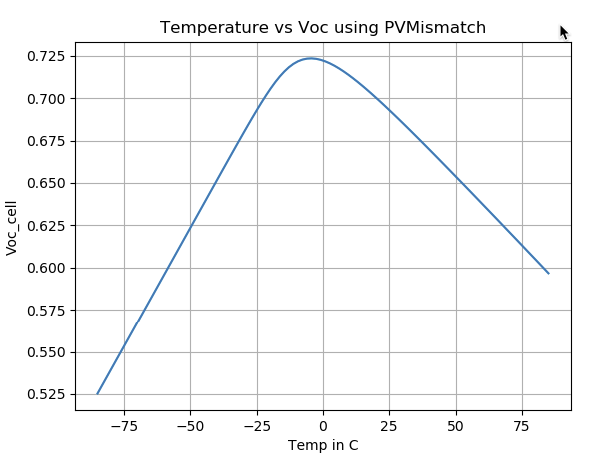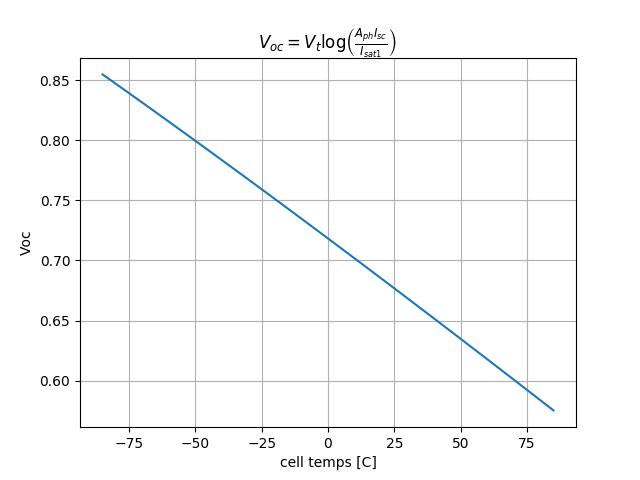If you make a cell position pattern that mimics a standard serpentine module the simulation fails.
>>> std72 = [
[[{'circuit': 'series', 'idx': 0},
{'circuit': 'series', 'idx': 1},
{'circuit': 'series', 'idx': 2},
{'circuit': 'series', 'idx': 3},
{'circuit': 'series', 'idx': 4},
{'circuit': 'series', 'idx': 5},
{'circuit': 'series', 'idx': 6},
{'circuit': 'series', 'idx': 7},
{'circuit': 'series', 'idx': 8},
{'circuit': 'series', 'idx': 9},
{'circuit': 'series', 'idx': 10},
{'circuit': 'parallel', 'idx': 11}],
[{'circuit': 'parallel', 'idx': 23},
{'circuit': 'series', 'idx': 22},
{'circuit': 'series', 'idx': 21},
{'circuit': 'series', 'idx': 20},
{'circuit': 'series', 'idx': 19},
{'circuit': 'series', 'idx': 18},
{'circuit': 'series', 'idx': 17},
{'circuit': 'series', 'idx': 16},
{'circuit': 'series', 'idx': 15},
{'circuit': 'series', 'idx': 14},
{'circuit': 'series', 'idx': 13},
{'circuit': 'series', 'idx': 12}]],
[[{'circuit': 'series', 'idx': 24},
{'circuit': 'series', 'idx': 25},
{'circuit': 'series', 'idx': 26},
{'circuit': 'series', 'idx': 27},
{'circuit': 'series', 'idx': 28},
{'circuit': 'series', 'idx': 29},
{'circuit': 'series', 'idx': 30},
{'circuit': 'series', 'idx': 31},
{'circuit': 'series', 'idx': 32},
{'circuit': 'series', 'idx': 33},
{'circuit': 'series', 'idx': 34},
{'circuit': 'parallel', 'idx': 35}],
[{'circuit': 'parallel', 'idx': 47},
{'circuit': 'series', 'idx': 46},
{'circuit': 'series', 'idx': 45},
{'circuit': 'series', 'idx': 44},
{'circuit': 'series', 'idx': 43},
{'circuit': 'series', 'idx': 42},
{'circuit': 'series', 'idx': 41},
{'circuit': 'series', 'idx': 40},
{'circuit': 'series', 'idx': 39},
{'circuit': 'series', 'idx': 38},
{'circuit': 'series', 'idx': 37},
{'circuit': 'series', 'idx': 36}]],
[[{'circuit': 'series', 'idx': 48},
{'circuit': 'series', 'idx': 49},
{'circuit': 'series', 'idx': 50},
{'circuit': 'series', 'idx': 51},
{'circuit': 'series', 'idx': 52},
{'circuit': 'series', 'idx': 53},
{'circuit': 'series', 'idx': 54},
{'circuit': 'series', 'idx': 55},
{'circuit': 'series', 'idx': 56},
{'circuit': 'series', 'idx': 57},
{'circuit': 'series', 'idx': 58},
{'circuit': 'parallel', 'idx': 59}],
[{'circuit': 'parallel', 'idx': 71},
{'circuit': 'series', 'idx': 70},
{'circuit': 'series', 'idx': 69},
{'circuit': 'series', 'idx': 68},
{'circuit': 'series', 'idx': 67},
{'circuit': 'series', 'idx': 66},
{'circuit': 'series', 'idx': 65},
{'circuit': 'series', 'idx': 64},
{'circuit': 'series', 'idx': 63},
{'circuit': 'series', 'idx': 62},
{'circuit': 'series', 'idx': 61},
{'circuit': 'series', 'idx': 60}]]
]
>>> pvsys = pvsystem.PVsystem(numberMods=8, numberStrs=2, pvmods=pvmodule.PVmodule(std72))
---------------------------------------------------------------------------
Exception Traceback (most recent call last)
<ipython-input-29-5843f6d31c33> in <module>()
----> 1 pvsys2 = pvsystem.PVsystem(numberMods=8, numberStrs=2, pvmods=pvmodule.PVmodule(std72a))
C:\Users\mmikofski\Documents\Projects\PVMismatch\pvmismatch\pvmismatch_lib\pvmodule.pyc in __init__(self, cell_pos, pvcells, pvconst, Vbypass, cellArea)
131 self.subStrCells = [len(_) for _ in self.cell_pos] #: cells per substr
132 # initialize members so PyLint doesn't get upset
--> 133 self.Imod, self.Vmod, self.Pmod, self.Vsubstr = self.calcMod()
134
135 # TODO: use __getattr__ to check for updates to pvcells
C:\Users\mmikofski\Documents\Projects\PVMismatch\pvmismatch\pvmismatch_lib\pvmodule.pyc in calcMod(self)
257 # TODO: use pvmismatch exceptions
258 raise Exception(
--> 259 "First row and last rows must be crosstied."
260 )
261 elif len(idxs) > 1:
Exception: First row and last rows must be crosstied.





